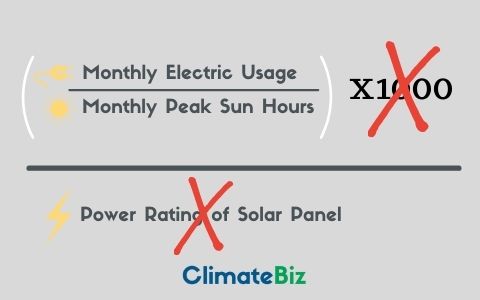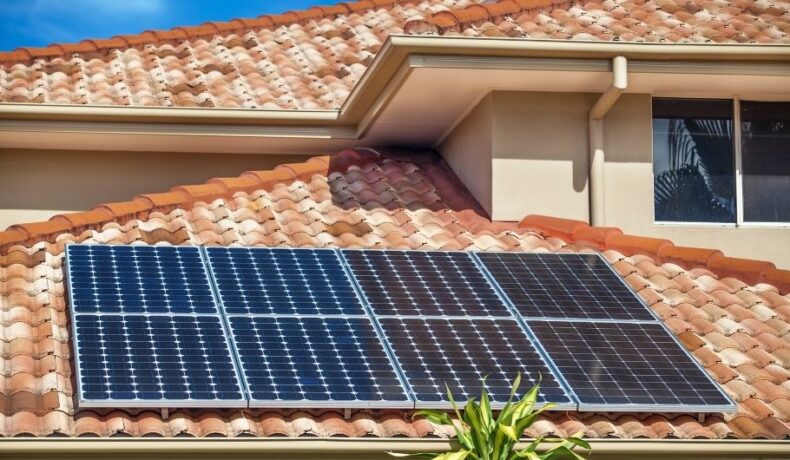Knowing how many solar panels your home needs is the first step in establishing your future budget.
Several 400-watt solar panels are going to cost you significantly more than say only two solar panels.
With this logic in place, it stands to reason why so many people want to know how much solar panels are needed for a home that uses 1,000kWh per month.
The number of solar panels needed directly correlates to solar irradiance and the output power of each solar panel. Monthly electricity usage ÷ monthly peak sun hours x 1000 ÷ power rating of solar panel. 1000kWh ÷ 160 hours x 1000 = 6250 ÷ 400W = 15,62 Solar panels are needed for 1000kWh.
In this article, we are going to teach you how to use this formula yourself so that you’ll be able to budget your own solar build without the help of a solar calculator.
Table of Contents
How Many Solar Panels Do I Need For 1,000 kWh Per Month?
First and foremost, it’s important that you understand that the answer to this question depends entirely on where you live and what sort of power rating your (desired) solar panels will be.
Anyone who gives you an answer without this information is, well, giving you inaccurate information.
This is why we are going to teach you how to figure out how many solar panels your own home will need, assuming you consume 1000kWh of electricity each month.

This formula right here is going to be your golden ticket to figuring out how many solar panels your household needs.
It is going to allow you to budget accordingly, so pay close attention to the next few paragraphs where we teach you how to use it.
- Monthly electric usage
- Monthly peak sun hours
- Power rating of solar panel
Electricity consumption
Firstly, how much electricity do you consume?
We already know in this case you consume 1000kWh a month. (The average American consumption is 893kWh by the way.)
Peak sun hours
Next, you need to figure out how many monthly peak hours of sunlight your area receives.
Luckily for you, we’ve made an easy resource for Americans, Australians, South Africans and Brits to figure out their area’s daily peak sun hours.
Peak sun hours are critical in knowing how many solar panels you will need for 1000kWh. The reason for this should be easy to understand.
The more sun that hits your solar panel, the more electricity it’s going to produce, likewise for the opposite side of the ratio.
Essentially, a peak sun hour equates to 1 hour in which the sun’s solar irradiance (sunlight) produces an average of 1000W (energy) per square meter (roughly 10.5 feet). In other words: 1 peak sun hour = 1000 W/m² of sunlight per hour.
For this example, let’s assume you live in California, which receives 5.2 peak sun hours daily.
Now we multiply that number by 31 days to get a monthly amount of 161,2.
Times by 1000
So, we have established the following, 1000kWh ÷ 161,2 = 6,2 x 1000 = 6203.
Power rating of solar panel
The last part of the formula all depends on what sort of solar panels you plan on buying for your home solar installation, it could be a 100W, 400W, 500W?
Most residential solar installations use 400-watt solar panels. The reason for this is you get more power output per square footage.
So, to continue our example on figuring out how many solar panels you need for 1000kWh, now you need to divide 6203 by the solar panel power output (400W in this case).
6203 ÷ 400W = 15,50 (you can round that off to 16).
Solar panels needed for 1000kWh
If you live in California, chances are you are going to need sixteen 400W solar panels in order to offset your 1000kWh electricity consumption each month.
Now of course this will change depending on where you live and what type of solar panel you use.
For example, let’s take the exact same scenario for someone living in London.
1,000kWh ÷ 86,8 = 11,52 x 1000 = 11,520.
11,520 ÷ 400W = 28,8 (round that off to 29)
As you can see a home located in London using the exact same amount of electricity as someone in California will need 29 solar panels instead of 16 in order to offset their consumption.
Peak sun hours play a major role in establishing how many solar panels you will need (for any scenario).
So if someone goes ahead and tells you, you will need 20 solar panels for 1,000kWh – They are wrong. It all depends on where you live and what power rating your solar panels will be.
How Much Does a 1000kWh Solar System Cost?
The answer to this again depends on where you live in this world.
Each country has a different economic situation and thus establishing a universal cost for solar panels is not possible.
For Americans, this is the average expected cost of solar panels per system size.
| SYSTEM SIZE | AVERAGE SOLAR PANEL SYSTEM COST (BEFORE TAX CREDITS) | AVERAGE SOLAR PANEL SYSTEM COST (AFTER TAX CREDITS) |
|---|---|---|
| 2 kW | $5,620 | $4,159 |
| 3 kW | $8,430 | $6,238 |
| 4 kW | $11,240 | $8,318 |
| 5 kW | $14,050 | $10,397 |
| 6 kW | $16,860 | $12,476 |
| 7 kW | $19,670 | $14,556 |
| 8 kW | $22,480 | $16,635 |
| 9 kW | $25,290 | $18,715 |
| 10 kW | $28,100 | $20,794 |
| 12 kW | $33,720 | $24,953 |
| 15 kW | $42,150 | $31,191 |
| 20 kW | $56,200 | $41,588 |
| 25 kW | $70,250 | $51,985 |
To figure out what size system your home will need, just use our formula again.
Except for this time, don’t times by 1000 or divide by the power rating.

So a household that lives in California and consumes 1000kWh a month will require a 6.2kW solar system to offset their energy needs.
1000kWh ÷ 161,2 = 6,2
A 6.2kW solar system that produces 1000kWh a month will cost you about $12,500 after tax rebates in California.
Now, let’s use the same formula but assume you live in Alaska.
1000kWh ÷ 77,5 = 12,90 (round off to 13)
In order to offset 1000kWh of consumption, you will need a 13kW solar system, which will cost you around $25,000.
Peak sun hours have a MASSIVE effect on how much your 1000kWh solar system will cost you.
How Much Will a 1000kWh Solar System Save Me?
This one is easy.
In order to know how much your 1000kWh solar system will save you, you need to know how much you pay for electricity in your country.
If you install a solar system that offsets 100% of your electricity consumption, you will essentially save the amount you would have spent on electricity each month.
So for someone living in the USA spending an average of $0.150 per kWh. You would save approximately $150 every month with a 1000kWh solar installation.
Assuming you spent $12,500 on your solar panels, you would make back your solar investment within 6,9 years.
From that point on you will literally be saving $150 for the next 23 years (most solar panels last between 25 – 30 years).
So in 23 years, your 1000kWh solar system will save you a whopping $41,400 in total!
Worth it? We think so.
Final Thoughts
Based on the above data we are sure you can see (at least financially, not to mention sustainably) how worthy a 1000kWh solar panel system is of your one-time investment.
The most important thing to keep in mind when calculating the number of solar panels your home needs is the amount of peak sun hours your home receives and what power rating your solar panels will be.
Feel free to post any of your questions in the comments section below if you are still unsure of how the formula works. We will get back to you as quickly as we can – Which is usually quite quick.

